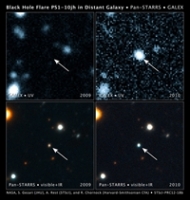May 17, 2012
|
Scientists were able to observe the demise of a star and its digestion by a previously dormant supermassive black hole in real time. f a star passes too close to a black hole, tidal forces can rip it apart, and its constituent gases then swirl in toward the black hole. Friction heats the gases and causes them to glow. By searching for newly glowing supermassive black holes, astronomers can spot them in the midst of a feast. Harvard Professor Edo Berger is a co-author on this study. Read more at Astronomy Magazine or read the CFA press release. |
 Credit: NASA/S. Gezari (JHU)/A. Rest (STScI)/R. Chornock (Harvard-Smithsonian CfA) |